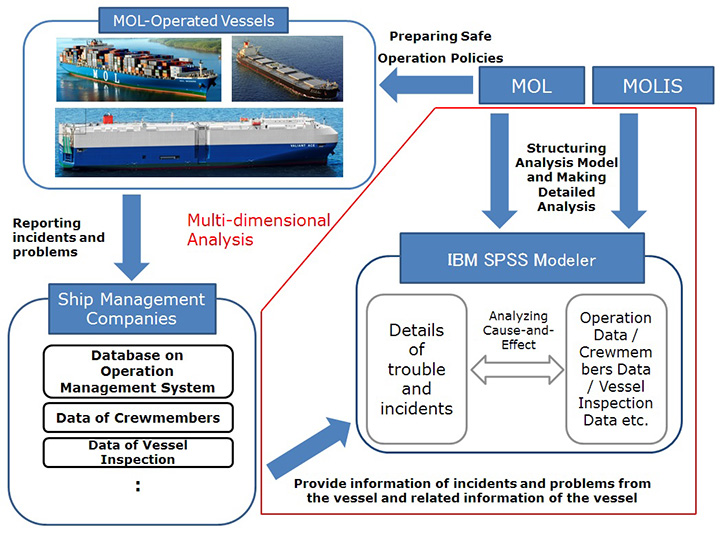- JP
- EN
MOL Starts Multi-dimensional Analysis of Causes for Incidents/Problems on its Operated Vessels
- Aims to Enhance Operation Support Services in Quest for Greater Safety and Efficiency -
December 04, 2017
TOKYO-Mitsui O.S.K. Lines, Ltd. (MOL; President & CEO: Junichiro Ikeda) today announced that in December 2017, MOL and MOL Information Systems, Ltd. (MOLIS; President: Nobunaga Shima; headquarters: Minato-ku, Tokyo) (Note 1) start multi-dimensional analysis of the causes for incidents and problems on its operated vessels, using IBM's statistical analysis software, "IBM SPSS Modeler" (Note 2).
The MOL Group has conventionally aggregated incidents and problems data reported by its operated vessels to "visualize" safe operation. And from now on, the group will develop more effective measures to prevent incidents and verify the effects by analyzing correlations and causal relationship of data from multiple sources (for example, operation data, crewmember data, vessel inspection data, and so on). In addition, it will build a new analysis method using the text mining function (Note 3), for some elements of unstructured data (Note 4), such as near misses gathered from crewmembers.
Prior to this analysis, the group held a three-month trial starting in July 2017 and built analysis models that verify causal relationship of information on crewmembers, such as downtime problems and years of onboard experience.
The MOL Group continually uses and applies ICT technology in a proactive manner, with the aim ensuring safe, stable cargo transport and becoming the world leader in safe operation.
| (Note 1) | MOLIS: MOL's wholly-owned consolidated subsidiary. It builds, maintains, and manages systems and networks in the MOL Group. |
| (Note 2) | IBM SPSS Modeler: Advanced data analysis software that provides prospective analysis from mass volume of data and supports better decision making to solve business issues. |
| (Note 3) | Text mining function: The analysis method for text data retrieves useful information by dividing data comprised of documents by word and paragraph, and analyzing the correlation of frequencies of words, frequency of commonly used words, and time sequence. |
| (Note 4) | Unstructured data: The information that does not have pre-defined data models, such as images, audio, and documents, and is not organized in a pre-defined manner. |

Multidimensional analysis of causes for incidents and problems
